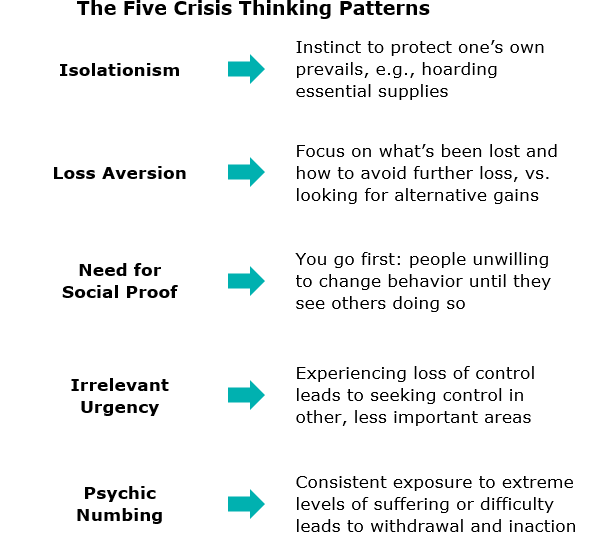4 lessons from university presidents on crisis thinking and resilient leadership
A crisis such as COVID-19 poses countless urgent decisions that are difficult for leaders to prioritize, often at the expense of long-term strategy. This fall, I sat down with more than two dozen college and university presidents for a roundtable discussion on avoiding the pitfalls of crisis thinking and building a culture of resilient leadership on campus. During our 90-minute discussion, I drew upon EAB’s research on leadership and strategy and participants’ experiences to explore important strategies for building resilience among campus leaders.
There are four central takeaways for building a culture of resilient leadership.
“Our executive team is managing the crisis day-to-day – hundreds of operational decisions. We’re frankly exhausted. But what worries me most is that the urgent is crowding out time for strategy – are we prioritizing the right things? How do we survive at the end of this, or not end up being a shell of our former self?”
–President Large Research University
1. Resilience must be practiced to be effective
In moments – or months – of crisis, institutional leaders bear the responsibility of shepherding their enormous flock of students, staff, and faculty to a place of stability and safety. It’s no easy task, and one that is only made more difficult by crisis thinking, the destructive thought and decision patterns that hinder a leader’s ability to think and strategize clearly under pressure. Leaders with cognitive flexibility, better known as resilience, overcome crisis thinking by holding a strong sense of purpose, an openness to question fundamental assumptions, and mindful thinking outside of their daily responsibilities.
SHIFTING FROM CRISIS RESPONSE TO STRATEGIC THINKING
The leaders present at our meeting discussed how it can be difficult to accept that they are not immune to stress-induced whims or short-sighted strategy at times of crisis. However, they learned that crisis thinking is something that no one is safe from. Even the strongest leaders recognize that a resilient, open mindset is not an innate personality trait – it is made strong and effective through practice.
2. Irrelevant urgency doesn’t have to be the bane of strategy and progress – if you can see it
In our discussion, leaders spent time reflecting on their own thought patterns during a crisis to identify the patterns that plague them the most often. When asked which of the crisis thinking patterns they encountered most often, the participating presidents called out irrelevant urgency as their most common pitfall (though noted they wouldn’t be hard pressed to come up with examples for each of the five).

Irrelevant urgency severely slows down decision making by elevating less strategic decisions to senior-most leaders. One president described the two-hour meeting they had with a colleague to determine the best brand of hand sanitizer to distribute across campus. This type of task – so menial yet somehow pressing in the moment – should have been delegated to someone besides the president to free up their time to focus on larger strategic priorities. With mindfulness of crisis thinking pitfalls, leaders can avoid this type of irrelevant urgency and claim time back for important strategic decisions.
3. Presidents don’t want urgency to dominate their to-do list
Almost all participants agreed they struggle with irrelevant urgency. Yet, they also stated they were ready to pivot back to long-term strategy and could not allow COVID-19 to continue to dominate decisions. Eighty-eight percent of presidents planned to focus on long-term projects during fall 2021. They were also confident that their teams can balance long-term progress and COVID response. That being said, 85 percent of presidents agreed that their leadership team is likely to prioritize urgent decisions over strategically important decisions. Leaders have a strong vision for institutional success but struggle to implement that vision amid a crisis such as COVID.
4. Pre-pandemic priorities are still top of mind
Despite the vast upheaval to higher education’s delivery model during COVID, Presidents overwhelmingly agreed that enrollment remains a top (if not the top) strategic priority. This focus underlines a clear sentiment among the presidents at the session: Top priorities did not change or go away during the pandemic — they were simply made more complicated.
To help provide support on this top issue, EAB is highlighting new strategies on how market share and demographics should guide revenue strategy in our webinar, Beyond Demographic Decline: The Hidden Trends Shaping Your Next Decade of Growth. Click here to download the presentation slides.

More Blogs

What our global partners asked us most in 2025

The real demographic crisis isn't national—it's regional
